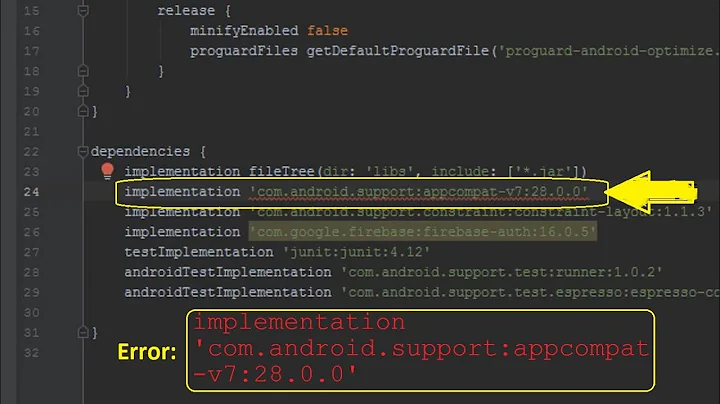Installing a support library for PreferenceFragmentCompat
Solution 1
After adding com.android.support:preference-v7:23.0.1 to your build.gradle file, simply change the line
For AndroidX : androidx.preference:preference:1.0.0
public class SettingsFragment extends PreferenceFragment {
to
public class SettingsFragment extends PreferenceFragmentCompat {
The error is caused by PreferenceFragment, which extends android.app.Fragment, not android.support.v4.app.Fragment which you need, as you are using support library class.
Solution 2
For anyone using androidx, add this to your dependencies
dependencies {
...
implementation 'androidx.preference:preference:{your_version}'
// example: implementation 'androidx.preference:preference:1.1.1'
}
Related videos on Youtube
Comments
-
 siriuseteor77 almost 2 years
siriuseteor77 almost 2 yearsI'm new to Android Studio and a total beginner at Android programming in general. I looked and looked and I couldn't find the right thing to do.
All I want is to install a library to use PreferenceFragmentCompat or any class that replaces android.app.PreferenceFragment so my app can work in API 11 and lower.
Can anyone please give me some details such as which library should I use and how to install it in my AS project.
Edit: So I started developing this app using
android.support.v4andandroid.support.v7libraries to handle the Fragments so I can run it on API 11 and lower.this is my MainActivity.java.
package com.example.myapplication; import android.app.Activity; import android.content.Intent; import android.net.Uri; import android.support.v4.app.Fragment; import android.support.v4.app.FragmentManager; import android.support.v7.app.AppCompatActivity; import android.support.v7.app.ActionBar; import android.content.Context; import android.os.Build; import android.os.Bundle; import android.view.Gravity; import android.view.LayoutInflater; import android.view.Menu; import android.view.MenuItem; import android.view.View; import android.view.ViewGroup; import android.support.v4.widget.DrawerLayout; import android.widget.ArrayAdapter; import android.widget.TextView; public class MainActivity extends AppCompatActivity implements NavigationDrawerFragment.NavigationDrawerCallbacks { /** * Fragment managing the behaviors, interactions and presentation of the navigation drawer. */ private NavigationDrawerFragment mNavigationDrawerFragment; /** * Used to store the last screen title. For use in {@link #restoreActionBar()}. */ private CharSequence mTitle; @Override protected void onCreate(Bundle savedInstanceState) { super.onCreate(savedInstanceState); setContentView(R.layout.activity_main); mNavigationDrawerFragment = (NavigationDrawerFragment) getSupportFragmentManager().findFragmentById(R.id.navigation_drawer); mTitle = getTitle(); // Set up the drawer. mNavigationDrawerFragment.setUp( R.id.navigation_drawer, (DrawerLayout) findViewById(R.id.drawer_layout)); } @Override public void onNavigationDrawerItemSelected(int position) { Fragment mainFragment = null; switch(position) { case 0: // home fragment mainFragment = new HomeFragment(); break; case 1: // favorites list mainFragment = new FaveFragment(); break; case 2: // rate app /* visit app TODO put application package id in the link */ Intent visitStore = new Intent(Intent.ACTION_VIEW); visitStore.setData(Uri.parse("market://details?id=com.google.android.apps.maps")); startActivity(visitStore); break; case 3: // settings mainFragment = new SettingsFragment(); break; case 4: // about mainFragment = new AboutFragment(); break; } if(position != 2) { // update the main content by replacing fragments FragmentManager fragmentManager = getSupportFragmentManager(); fragmentManager.beginTransaction() .replace(R.id.container, mainFragment) .commit(); } } public void onSectionAttached(int number) { String[] stringArray = getResources().getStringArray(R.array.section_titles); if (number >= 1) { mTitle = stringArray[number - 1]; } } public void restoreActionBar() { ActionBar actionBar = getSupportActionBar(); actionBar.setNavigationMode(ActionBar.NAVIGATION_MODE_STANDARD); actionBar.setDisplayShowTitleEnabled(true); actionBar.setTitle(mTitle); } @Override public boolean onCreateOptionsMenu(Menu menu) { if (!mNavigationDrawerFragment.isDrawerOpen()) { // Only show items in the action bar relevant to this screen // if the drawer is not showing. Otherwise, let the drawer // decide what to show in the action bar. getMenuInflater().inflate(R.menu.main, menu); restoreActionBar(); return true; } return super.onCreateOptionsMenu(menu); } @Override public boolean onOptionsItemSelected(MenuItem item) { // Handle action bar item clicks here. The action bar will // automatically handle clicks on the Home/Up button, so long // as you specify a parent activity in AndroidManifest.xml. int id = item.getItemId(); //noinspection SimplifiableIfStatement if (id == R.id.action_settings) { return true; } return super.onOptionsItemSelected(item); } /** * A placeholder fragment containing a simple view. */ public static class PlaceholderFragment extends Fragment { /** * The fragment argument representing the section number for this * fragment. */ private static final String ARG_SECTION_NUMBER = "section_number"; /** * Returns a new instance of this fragment for the given section * number. */ public static PlaceholderFragment newInstance(int sectionNumber) { PlaceholderFragment fragment = new PlaceholderFragment(); Bundle args = new Bundle(); args.putInt(ARG_SECTION_NUMBER, sectionNumber); fragment.setArguments(args); return fragment; } public PlaceholderFragment() { } @Override public View onCreateView(LayoutInflater inflater, ViewGroup container, Bundle savedInstanceState) { View rootView = inflater.inflate(R.layout.fragment_main, container, false); return rootView; } @Override public void onAttach(Activity activity) { super.onAttach(activity); ((MainActivity) activity).onSectionAttached( getArguments().getInt(ARG_SECTION_NUMBER)); } } }Now this is my SettingsFragment.java:
package com.example.myapplication; import android.os.Bundle; import android.preference.PreferenceFragment; public class SettingsFragment extends PreferenceFragment { @Override public void onCreate(Bundle savedInstanceState) { super.onCreate(savedInstanceState); addPreferencesFromResource(R.xml.settings); } }The real problem I encounter here is with this line:
mainFragment = new SettingsFragment();in theonNavigationDrawerItemSelected(int position)method in MainActivity.java.It returns an error saying:
Error:(70, 32) error: incompatible types: SettingsFragment cannot be converted to Fragment
How can I fix this and still be able to use my app on API 11 and lower?
-
 Mariano Zorrilla almost 9 yearsThe question is a bit too board. You can check this example: cs.dartmouth.edu/~campbell/cs65/lecture12/lecture12.html but you should try to start with some codes and the ask for help when you're stuck with it. I don't see any "PreferenceFragmentCompact" anywhere
Mariano Zorrilla almost 9 yearsThe question is a bit too board. You can check this example: cs.dartmouth.edu/~campbell/cs65/lecture12/lecture12.html but you should try to start with some codes and the ask for help when you're stuck with it. I don't see any "PreferenceFragmentCompact" anywhere -
 siriuseteor77 almost 9 yearsyou're right, editing it
siriuseteor77 almost 9 yearsyou're right, editing it -
 Mariano Zorrilla almost 9 yearsRead this: stackoverflow.com/questions/10405773/… there it says how to open a PreferenceFragment/Activity.
Mariano Zorrilla almost 9 yearsRead this: stackoverflow.com/questions/10405773/… there it says how to open a PreferenceFragment/Activity. -
 siriuseteor77 almost 9 yearsI don't know how is that going to help me?
siriuseteor77 almost 9 yearsI don't know how is that going to help me? -
 Mariano Zorrilla almost 9 yearsYou are trying to open the PreferenceFragment as a regular Fragment and that is not going to work (because is not a "Fragment"). You need a header for the PreferenceActivity and that one will open the PreferenceFragment.
Mariano Zorrilla almost 9 yearsYou are trying to open the PreferenceFragment as a regular Fragment and that is not going to work (because is not a "Fragment"). You need a header for the PreferenceActivity and that one will open the PreferenceFragment. -
 Mariano Zorrilla almost 9 years"You'll need a header listing for each preference screen (fragment)." read the answer there... is the solution.
Mariano Zorrilla almost 9 years"You'll need a header listing for each preference screen (fragment)." read the answer there... is the solution. -
 siriuseteor77 almost 9 yearsI'll fix that but the issue I want fixed is that android.preference.PreferenceFragment only runs with API 11 and higher and I want my app to work with APIs lower than that..
siriuseteor77 almost 9 yearsI'll fix that but the issue I want fixed is that android.preference.PreferenceFragment only runs with API 11 and higher and I want my app to work with APIs lower than that.. -
 Mariano Zorrilla almost 9 yearsWell... PreferenceFragment is just a SharedPreference "view". You can use my library github.com/mkiisoft/KeySaver it's a easy version of SharedPreference and it works from Android 2.1 You can save the data there, get the values and ask if exist or not.
Mariano Zorrilla almost 9 yearsWell... PreferenceFragment is just a SharedPreference "view". You can use my library github.com/mkiisoft/KeySaver it's a easy version of SharedPreference and it works from Android 2.1 You can save the data there, get the values and ask if exist or not. -
 siriuseteor77 almost 9 yearsLet us continue this discussion in chat.
siriuseteor77 almost 9 yearsLet us continue this discussion in chat.
-
-
 siriuseteor77 almost 9 yearsI don't have the library that contains the PreferenceFragmentCompact installed, what is that library called and how can I install it on AS?
siriuseteor77 almost 9 yearsI don't have the library that contains the PreferenceFragmentCompact installed, what is that library called and how can I install it on AS? -
Derek Fung almost 9 yearsadd
compile 'com.android.support:preference-v7:23.0.1'to your gradle -
 siriuseteor77 almost 9 yearsThis worked, thanks. I needed to install the library.
siriuseteor77 almost 9 yearsThis worked, thanks. I needed to install the library. -
Sasha over 8 yearsdon't forget to update to the new version. It has some impotent bug fix: compile "com.android.support:preference-v7:23.1.0"
-
Dusko over 8 yearsa noob question I guess: where do you see the info in which library it is? I mean, how do you know to add the particular compile statement? Because when I read through the PreferenceFragmentCompat documentation it says nothing about adding this compile statement, I have to go to Support Library in documentation and basically keep up to date if anything changes so I wonder if there is a more straightforward way to know what to compile without too much digging around?
-
Amit Trivedi over 8 years
-
Al Lelopath over 7 yearsCheck here for latest version of the support preference library.
-
TOP over 7 yearsCan I use this library for compile SDK 22?
-
 Aleksandar Belic over 5 yearsPreference releases can be found here: developer.android.com/jetpack/androidx/releases/preference
Aleksandar Belic over 5 yearsPreference releases can be found here: developer.android.com/jetpack/androidx/releases/preference





![[ブログ用] PreferenceFragmentCompat デモ](https://i.ytimg.com/vi_webp/gzg4bhZXXU0/maxres2.webp)
